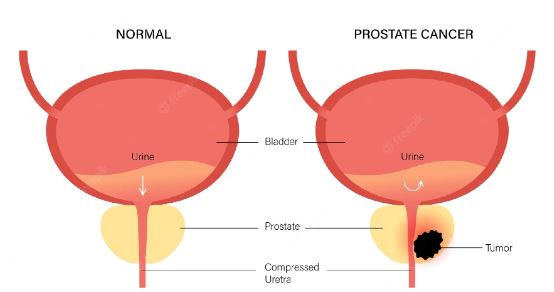Prostate cancer is a common form of cancer among men. Understanding its causes,
symptoms and treatment options is essential for anyone at risk. Prostate cancer
happens when abnormal cells grow in the prostate, a gland located near the bladder in
men. As the cancer cells multiply, they can rapidly spread to other areas of the body.
Hence, early detection and treatment is important. Symptoms of prostate cancer can
include difficulty urinating, frequent urination, and pain or burning during urination.
Treatment options range from lifestyle changes, medication, and surgery and radiation
therapy. In addition to understanding the causes, symptoms and treatment options, it is
also important to know the risk factors associated with prostate cancer, such as age,
family history, and race. By becoming more knowledgeable about prostate cancer and
its associated risks, men can make informed decisions about their health and how to
best manage the condition.
What is prostate cancer?
Prostate cancer is a common type of cancer that typically affects men over 50. The
prostate is a small gland in the pelvis near the bladder. Normally, it produces a fluid that
helps sperm move, but it also can become cancerous. The prostate cancer diagnosis
can be very scary, but it is curable or/and manageable. The type of prostate cancer you
have depends on how quickly the cells grow and spread. There are several types of
prostate cancer. They are all treated differently. One of the most common types is
prostate adenocarcinoma. It accounts for about 80% of cases and grows slowly. For this
reason, it is often found in advanced stage. Men who are diagnosed with prostate cancer
are often treated with surgery to remove the prostate gland, radiation therapy, and/or
hormone therapy. They often find that living with the disease can be challenging as it
can require a commitment to self-care and health maintenance. Living with prostate
cancer requires that men maintain a healthy diet, exercise regularly, and receive regular
screenings.
There are two types of adenocarcinoma;
Acinar adenocarcinoma of the prostate
Most people have this type. It develops in the gland cells that line the prostate gland.
Ductal adenocarcinoma of the prostate
Ductal adenocarcinoma starts in the cells that line the tubes (ducts) of the prostate
gland. It tends to grow and spread more quickly than acinar adenocarcinoma.

Causes of prostate cancer
As with many health conditions, the exact cause of prostate cancer is unknown.
However, research has found several factors that may increase a person’s risk of
developing the disease. These risk factors include age, family history, and race. Age –
Men who are over 50 are at a higher risk of developing prostate cancer than younger
men. Family history – Having a first-degree relative (parent, sibling, or child) diagnosed
with prostate cancer increases a person’s risk of developing the disease. Race –men of
African descent have a higher risk of developing prostate cancer than men of other
races. Studies show that black men are 50% more likely to develop the disease and
twice as likely to die from it.
Symptoms of prostate cancer
Some symptoms of prostate cancer are more common than others. They may include
difficulty urinating, frequent urination, and pain or burning during urination. Other
symptoms can include blood in the urine, pain in the lower back, hips, or pelvis, and
feelings of pressure in the bladder. These symptoms can also accompany other
diseases, so it is important to see a doctor before self-diagnosing. A doctor can
diagnose prostate cancer by examining the prostate and testing a sample of urine. If the
doctor finds signs of cancer, he or she will order more tests to determine how far it has
spread and what stage of cancer the patient has. These tests include a physical exam,
blood tests, and imaging scans.
Risk factors for prostate cancer
Age – The risk of developing prostate cancer increases with age. Men over 50 are more
likely to develop prostate cancer than younger men.
Race – African American men and men of Asian descent have a greater risk of
developing prostate cancer than men of other races.
Family history – Men who have a first-degree relative (parent, sibling, or child) diagnosed
with prostate cancer are at an increased risk of developing the disease.
Diagnosing prostate cancer
Men should know the signs and symptoms of prostate cancer. They should also be
familiar with the recommended screenings and diagnostic procedures to detect and
diagnose the disease. Men over the age of 50 are encouraged to have regular
screenings for prostate cancer, which can include a prostate-specific antigen (PSA)
blood test or a digital rectal exam (DRE). These tests can help a doctor determine
whether there are any signs of cancer. A PSA blood test measures the level of PSA, a
protein produced by the prostate. If the level of PSA is high, it could be a sign of prostate
cancer. A DRE is a physical exam that a doctor performs by inserting a gloved finger into
the anus to feel for any lumps in the prostate.
Treatment options for prostate cancer
The type of prostate cancer one has will determine the treatment options for managing
the disease. Most prostate cancers are slow-growing and are treated with surgery to
remove the prostate gland, radiation therapy, and/or hormone therapy. Other types of
prostate cancers are aggressive and are treated with a combination of surgery, radiation
therapy, and hormone therapy.
Surgery – If a doctor finds early signs of cancer, he or she may recommend surgery to
remove the prostate gland.
Radiation therapy – If a doctor finds early signs of cancer, they may recommend
radiation therapy to kill the cancer cells. Radiation therapy (also called radiotherapy) is a
cancer treatment that uses high doses of radiation to kill cancer cells and shrink tumors
Hormone therapy – Men who have advanced prostate cancer may undergo hormone
therapy to slow the growth of or stop the cancer. Hormone therapy is a cancer treatment
that slows or stops the growth of cancer that uses hormones to grow. It can also be
called Endocrine therapy.
Side effects of prostate cancer treatments
Side effects of treatment vary depending on the specific treatment a man receives to
manage his prostate cancer. Some side effects of prostate cancer treatments include
impotence, incontinence, fatigue, diarrhea, and weight loss.
Impotence – Impotence, or erectile dysfunction, is a common side effect of prostate
cancer treatment.
Incontinence – Some men who undergo surgery to remove their prostate gland
experience incontinence, or the inability to control their bladder.
Fatigue – Some men who undergo treatment for prostate cancer experience fatigue,
which is a feeling of extreme tiredness.
Diarrhea – Some men who undergo surgery to remove their prostate gland experience
diarrhea as a side effect of treatment.
Weight loss – Some men who undergo treatment for prostate cancer experience weight
loss.
Living with prostate cancer
Once a man is diagnosed with prostate cancer, he is likely to face many challenges for
the rest of his life. It is important for men to accept the diagnosis and commit to self-care
and health maintenance, regardless of the type of cancer they have and their treatment
options. This may require a lifestyle change, including a healthier diet, increased
exercise, and regular screenings to monitor the disease and its progression. Men living
with prostate cancer may experience emotional and psychological distress, which can
have a significant impact on one’s mental and physical health. Support groups can be
helpful in managing the emotional impact of the diagnosis and the challenges of long-
term treatment.
Those diagnosed with prostate cancer can still live long fulfilled lives with proper
treatment and a few lifestyle and dietary changes. Just like most forms of cancer early
detection increases the chances of survival significantly so it is important that men pay
attention to the signals the body gives and regularly consult your doctor regarding
diagnoses and checks, especially if you’re among the groups of men more prone to
having this form of cancer.



